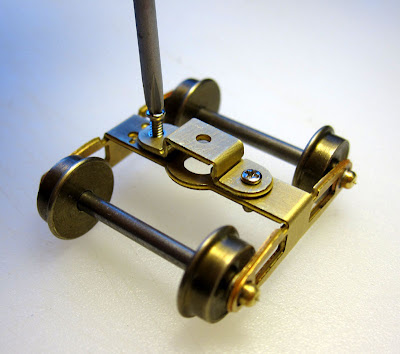Assembling the Hollywood Foundry Lightning Trailing Truck Kit
is actually easy-peasy!
The drive on my old Pacific Traction H.O scale San Diego 400 series car has had a full life. The gears are worn, the spring drive slides, even one of the tires has separated from the axle. It needs a whole new drive. Preferably a precision drive, capable of ultimate slow speed smooth running on tight city curves.
And Hollywood Foundry has (once again) come to the rescue with their magnificently designed Diablo Power Truck.
But, it comes as a kit, assembly required. Assembling such a precision
instrument can be a little intimidating. But Hollywood Foundry maintains
that its actually easy and quick to assemble.
So, to get an idea of what it will take to assemble the Diablo, why not assemble their Lightning Trailing Truck first? Their methods of assembly are very similar. And that's exactly what I did. Yes sir, that's exactly what I did.
Let me just say that the instructions are very well written with plenty of crystal clear illustrations accompanying the text. AND a color version of the instructions are available on-line for free. The rest of my post pretty much reiterates what already has been published. But if you want to see the assembly of the Lightning Truck in photos, well then, here you go:
But make sure you follow the instructions that come with the Lightning!
Only three tools are required to assemble the Lightning Truck. The first is a simple file to deburr the parts.
These bearings are what make the Lighting Truck such a great roller. The bearings can actually be dropped into place and will be trapped without fear of them falling out. Or you can glue them in. I chose to carefully solder them in place so that they will never be a problem. First I spread some solder (tinning) around the bearing itself, then, I tinned the truck frame around the hole. Then I dropped the bearing into the hole and heated the assembly until the bearing was properly seated in the hole.
Now comes the folding:
The only rule Hollywood Foundry has with bending the parts is that the metal is always folded towards the etched fold line.
Now comes the folding:
The only rule Hollywood Foundry has with bending the parts is that the metal is always folded towards the etched fold line.
Bending the parts are easy-peasy. Using the second tool, a smooth jaw pliers, to hold the part just below the etched fold line, I applied firm, balanced pressure with my finger, slowly bending the part into its correct position.
The opposite side of the truck frame is bent half way to first accept the wheelsets before bending fully into position.
I just realized the painting the wheelsets ahead of time would have been a good idea. Bending and unbending would cause the metal to harden and become brittle and could break. So this little planing ahead would help keep the truck sound.
With the wheelsets in place the frame is folded into position.
I made some slight adjustments to the folds for maximum "spinnage". And true to advertized, the wheels spin for quite a while when spun with a finger.
Now for the bolsters. A quick clean up with a file and were ready for...
...fold, fold, fold, fold.
Washers are included to adjust the height of the truck. But that will be determined when the Diablo is built and the height of the Lightning and Diablo need to be matched.
For reliable transfer of track power from the truck to the chassis, I soldered the lead to the nickel silver solder tag.
Now were ready to mount the truck.
First, place the Derlin washer and properly seat it into the hole.
Then place the truck on top and fit the screw through.
Flip the chassis over...
... and fit the second Derlin washer seated into the hole.
The nickle silver power tag is placed next and...
... place the nut and tighten moderately.
And there we go! Essentially the truck is assembled and installed. I just need to add the old side frames.
It was a simple matter of finding a drill bit with the same diameter as the bearings to enlarge the holes. Test fit. Drill some more. Test fit. Don't drill all the way through!
Then the sideframes were soldered on. And were good to go!
This all went together in about 45 minutes! And that includes stopping to compose these pictures.
I'm so ready to tackle the Diablo now because, I tell ya, I feel like a downright metal smith now! Yes sir! A downright metal smith!
I'm so ready to tackle the Diablo now because, I tell ya, I feel like a downright metal smith now! Yes sir! A downright metal smith!
Dandy




























Thanks,Dan, for the excellent pictures and blog - I'm now encouraged to try my hand at scratch-building a differential dump car. George
ReplyDeleteDan, thanks for the excellent article on the Lightening trail truck. One minor comment, turn the sideframe in the last picture right side up before the rivet counting nit-pickers notice it.
ReplyDeleteYou betcha guys! Glad to be of service.
ReplyDeleteGood eye Charlie! But that style of sideframe is actually of a unique patented design that has won several prestigious awards and- alright, you caught me, I screwed up. I'll go change it now. Thanks!
Best of luck with your differential dump car George, that should make for a fun project! And be careful with the correct orientation of those side frames!
Dandy